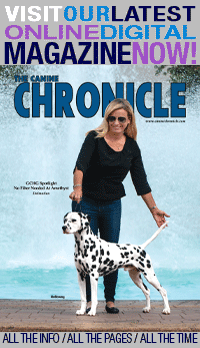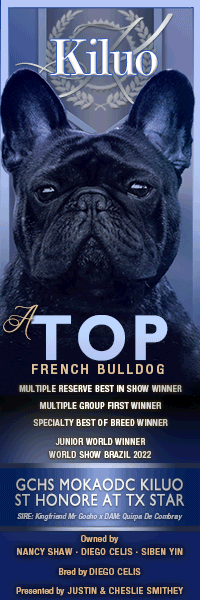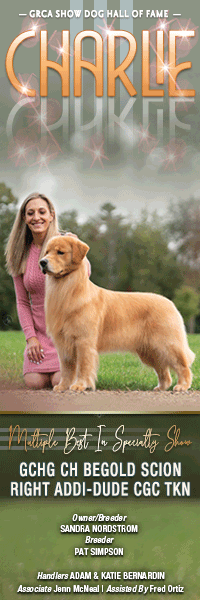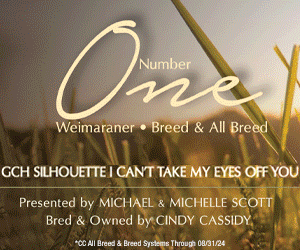Revisiting a Process
by Dr. Gareth Morgan-Jones
As yet another year draws to a close, it is surely appropriate and timely to once again revisit the state of our sport and, in particular, to offer some hopefully salient commentary on where things appear to stand with regard to certain aspects of governance. Specifically, it seems useful to revisit where exactly things appear to be with that central and pivotal issue of peer evaluation as it relates to the approval of judges.
In recent times a whole lot has been happening repeatedly in this area in a continuing and seemingly never-ending effort to get things right to presumably everyone’s satisfaction. And an abundant plethora of opinions have again, inevitably, been offered on the subject. The whole business is seen by some as a futile pursuit, given the many intangibles and convoluted challenges involved. But then this has historically been an area and matter where successive, cyclically-occurring attempts at improvement have been made.

So what’s new, one might well ask? Whether any meaningful progress has been sequentially made over time appears now to be arguably debatable. Why otherwise would there be a perceived need to repeatedly revisit? Why does this even happen? Volatility has certainly been the name of the game, with constantly changing procedures and personnel involvement becoming commonplace. Just when some permanence seems to be in prospect another upheaval ensues. Oftentimes this has been seen as counter-productive by many and ultimately a hindrance to the attainment of the desired goal.
Here is a relevant question? Have some babies been thrown out with the bathwater, inadvertently or otherwise? How many times has one heard someone or other offer a remark such as, ‘since they keep on changing the rules I don’t even want to mess with it anymore’? As a result of some of this, a realm of relentless negativity unfortunately gets generated, whether justified or not, and a world of gratuitous snarks becomes pervasive. Thumbs down to the takedowns say some, not so say others. So we reach a point where we are wondering whether or not we are even capable of precisely identifying an effective methodology, whether such a thing can even be realized by the mind, let alone be put into workable practice, and appraised at an actual or approximate value. Of course there are various ways and means of determining qualifications and merit, as used in the professions, so why are we constantly in this cauldron of uncertainty and, hence, this constantly transitory state?
From an outside-observer’s perspective, the most intriguing aspect in all of this surely revolves around the matter of causes and effects, as well as what stimulates and drives the engine, so to speak. Then there are modes of action to consider. Added to this is the question of what’s partly or mainly proactive and what’s been largely reactive. How do dissatisfactions expressed, especially if emanating from influential sources, resulting in reactions, match up against a genuine, dispassionate belief that there might be a better, more comprehensive and modern way of doing things? When things appear more or less settled, along comes another change. Is this just a matter of certain individuals imposing their will based on a conviction that their ideas as to how to do things are superior to those of their predecessors? Is there also an element of a perceived need to move with the times at play here? Hence, for example, the possible option of adopting an online distance-learning model for purposes of education and evaluation. How much collective, broad-based wisdom is going into all of the deliberations this time around? Just a question! There has obviously been some interplay between the views of those who believe simplification to be a desirable goal and those who think the more complex and technocratically-based the procedure, the more likely it is to be successful. There remains, of course, the question of acceptability. Drastically reduce the bureaucracy and considerably simplify things say some, including the leader of one of the judges’ organizations, make it more burdensome and cumbersome say others. Quite apart from the onerous logistics and appreciably-increased costs involved, there remains also the question of likely effectiveness. Hence we are probably witnessing a range of views from the utopian, that which is incapable of being realized or achieved, and a more realistic approach. What has been somewhat surprising in recent times is the rapidity with which a newly-instituted procedure has been summarily decommissioned and discarded, with attendant departure of some of the key figures charged with its implementation. Then there soon followed the introduction of a new committee structure which in due course inevitably gave rise to concerns about consistency and evenness of decision-making, given the rotating composition of the evaluative body. One supposes that the jury is still out on how well or otherwise this is working. One certainly hears different things! But then isn’t this always how things are?
To complicate matters further and surely to the astonishment and consternation of many there came the so-called ‘masking’ methodology which is still in place and has recently been strongly defended as useful and workable. The dust appears to be far from settled on this one, however, despite the fact that detailed assurances have been given concerning the depth and breadth of information on which judging approval decisions are currently being made. The point is well-taken that this, in all likelihood, at least somewhat reduces the chances of personal partisanship having a contaminating influence. But, some people are asking, were things that bad in this regard so as to make it absolutely necessary for such a draconian measure to be undertaken? How valid, in reality, was the perception that partisanship was being overtly practiced? How could this be accurately determined even if there might have been, in some instances, that whiff of favoritism doing the rounds? By innuendo or hearsay? This does, correctly or otherwise, raise the question of trust and ethics. There had to be a certain inference, the arriving at a particular conclusion, with an attendant stigma, at play. Opportunity for input had been opened up and with it came the possibility of abuse, an inevitability which was perhaps fully predictable. There was something implied, which does lead many to suspect that there was a reaction. Some folks might (reportedly) have felt shafted and hence went on the war path. Who knows? Next question; what is the likely downside? Quite obviously there seems some likelihood, or let’s say slight possibility, that an applicant’s true stature, reputation, experience and knowledge might not be adequately represented but the chances of this happening do seem, to be perfectly honest, somewhat remote. If, and it’s a big if, indeed an applicant’s judging history, in its totality, can be accurately documented and conveyed, concerns and misconceptions will presumably, to some extent at least, be neutralized.
To conclude this essay it might be useful to once again remind ourselves of some of the factors involved in attempting to determine whether or not an individual possesses an acceptable level of competency and proficiency. Some consideration of what is included in this activity serves this purpose. First of all let it be said that ability to evaluate exhibits well is the product of intelligence derived directly from a combination of knowledge and experience. Good judging, as I have suggested previously on a number of occasions, essentially involves efficiently relating confronted reality, in the form of actual exhibits, to concepts of what are deemed ideal. In order to not only accurately compare a number of dogs but to also quickly assess how each matches up, relative to others, to the dictates of a written standard, requires considerable background. This is where the visual, distance-learning envisaged in the AKC Judging Task Force’s canine education model will certainly be potentially useful. We are presumably thinking of complementariness here, rather than exclusivity; an added dimension to the learning experience that will facilitate the further development of intuitive awareness, recognition and appreciation. A certain cognition, the act of conscious knowing, followed by rational thought will, presumably, be nurtured. Quite obviously all of this involves much more than determining respective merit in terms of make and shape and movement characteristics. It should also include what one might refer to as the development of a feel for the essence of each breed, for that which we refer to as ‘type’. In order to fully achieve this, quite clearly, there is, however, no substitute for hands-on experience. That is surely a given. This does not always come easily, which accounts for the fact that some judging can best be described as being predominantly generic in nature. This is where the experience factor comes into play. It takes time and exposure to hone and fine-tune an understanding of the essential characteristics of any breed.
In the process of becoming sufficiently familiar with a breed to judge it competently and with discernment, a number of essential steps have to be taken. Three main actions are involved. First and foremost is the acquisition of basic knowledge, including particulars of origin, purpose, development, typifying characteristics, and so on. Then there comes the integration of this information into what one might refer to as a previously-possessed understanding of aspects such as canine anatomy and structure. Following this comes the application of the newly-obtained information and it is in this area that the greatest challenge lies. A conscientious judge surely continues to learn and thereby progressively hones and sharpens his or her skills. In the ongoing process, a sophisticated feel for each breed is systematically cultivated. Not to do so, more often than not, translates into generic judging. Looking for an overall picture of a dog is fine in and of itself but there is surely a little more to it than that. The ultimate learning in all of this comes with the doing and this is a developmental process. When someone says that their judging priorities do not ever change, do they mean in general terms or are they saying that they judge every breed in the same way over time? There is, of course, always a challenge in setting a balance and not to overly-emphasize one aspect or other. Take, for example, the matter of making a trade-off between a better-made exhibit versus one that exemplifies superior breed type. How does one weight the one against the other? On what basis does one prioritize? Obviously, in order to be prepared for this sort of choice, there has to be some prior awareness. Without broad experience, however much knowledge one possesses, there comes a time when difficult choices have to be made. I believe that it is true to say that our better judges have mastered their craft by lengthy and extensive practice. In this, the application of mental discipline as well as sound intellectual method is essential. The former is in part needed in order to neutralize over-emotional, subjective responses to reality. A judge may not always be fully aware of all of the influences which go into the act of reaching decisions but there has to be some control. Likewise a judge may think that he or she approaches the task in precisely the same way each time in the ring but may not in fact do so. Judging is not all about instinct and intuition. A perfectly valid decision does not, however, necessarily have to be based solely on reason. A proficient judge can evaluate some of they key features of a particular dog, such as profile, balance, and movement peculiarities, readily but after this comes the more sophisticated part which involves a consideration of that which we refer to as ‘type’. What is viewed by the mind as the relative importance of one thing or another at any given time may certainly vary. This is in the subjective nature of things. In trying to analyze and understand this evaluative process there are always going to be some intangibles. Ultimately, however, it has to be said that degree of competence largely depends upon the extent of a combination of knowledge and experience.
Click here to read the complete article from the Canine Chronicle The Annual 2013-14 Issue, Vol. 39 Number 1.
Short URL: https://caninechronicle.com/?p=40614
Comments are closed











